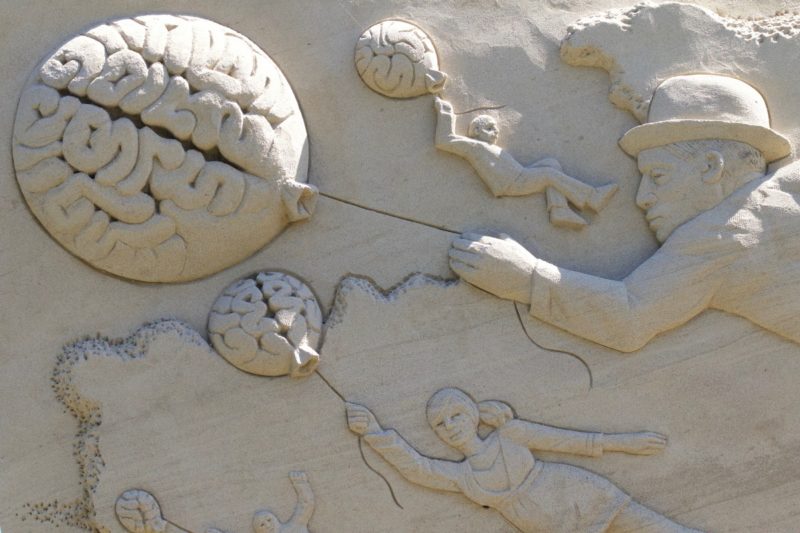Not without contingency, I was recently presented with an opportunity to listen to a radio interview with a neuroscientist and popular science blogger explain how psychological traits and tendencies emerge from underlying neurobiology and neurocircuitry.[1] Kevin Mitchell, Associate Professor of Genetics & Neuroscience, Trinity College Dublin was publicising his most recent book “Innate: How the Wiring of Our Brains Shapes Who We Are”[2] and began by premising that what makes us who we are lies in the hard wiring of the brain, that is, the connectivity between both different areas and circuitry functions of the brain. The causes of individual variances in human nature are therefore founded in our DNA, this being the nomination given to the genetically coded framework we inherit, and which programmes us. This established framework will be further modified with our life experiences thereby permitting changes in brain plasticity in order to accommodate learning.
However, a significant inherent randomness must be accounted for in the prenatal neural development of the brain. It is this contingent element of the brain wiring development process which then must further fan out to accommodate the distinction the author makes between “genetic” (heredity) and “innate” (natural) influences in order to cover all possible variations of human nature. For instance, our DNA determines physical manifestations such as skin tone, hair/eye colour etc, but also schizophrenia, autism and cystic fibrosis, the causes of which are located as inherited genetic conditions. Psychological “traits” on the other hand are deemed to be more “innate” without necessarily being inherited but result from the variable nature of neural development. The “traits” that the author highlights, are those of aggression, violence and criminality, each of which are innate manifestations acquired during the randomness of the brain development process. Coming to the end of the interview, the author goes on to state “a probabilistic relationship” between genetic composition and sexual orientation. Whilst the genetic (inherited) component increases “the likelihood of homosexuality,” the personality trait of homosexuality is also considered to be more innate. In fact, this is not so dissimilar in its origins to the “inborn nature” of psychopathic behaviour which he defines as a “callous unemotional trait.”
It is striking to note that the real of the sexual non-relation that the author evokes with homosexuality is decreed at the same time as both “genetic and innate”. No escaping ones’ fate then. A pictograph is clearly drawn for us of how genes in the body produce a complete organism wired up correctly, or not in the case of deviations, allied to innate predispositions which programme us in a totally explainable, logical way. This picture is one of determinism for many factors, with deviations from the norm explained by variances in the development of the brain. At no stage in the interview is there any hint of the possibility of a subject, one whose destiny is not already written before birth, within the confines of a predetermined programme; of a subject who may assume responsibility for his/her desire; of a subject who is implicated in the function and field of speech and language; of a subject whose history remains to become hystorised. What is presented in this version of humanity is an acephalic subject, but one programmed by a brain.
124 years ago, Freud’s “Entwurf” in 1895 sought to bring together a theory of the functioning of the nervous system and the brain “as a homeostat organ. And he then comes up against, he stumbles on, the dream. He realises that the brain is a dream machine. And it is in the dream machine that he rediscovers what was there all along and which hadn’t been noticed, namely, that it is at the most organic and most simple, most immediate and least manageable level, at the most unconscious level, that sense and speech are revealed and blossom forth in their entirety. Hence the complete revolution in his thinking, and the move to the Traumdeutung.”[3]
The inaugural dream of “Irma’s Injection,” the dream of all dreams revealed to Freud the true acephalic subject of the unconscious. He interprets the dream beyond egoic identifications, sees the horror of the formless flesh no longer veiled, his anxiety in the face of the real of overdetermined death to the formula of trimethylamine which is both the last word, or rather letter in its elemental form, bereft of sense. The letter which means nothing other than the real that evokes the sexual non-relation, a way to make do with jouissance, beyond the word, beyond sense. It is this non-sense that accompanies the introduction of language and makes its way as the underlining of the fictions that one believes is truth. It is with this non-sense that the real as non-representable finds a way to be read and structures each subject with reality.
This “voice which speaks in me, beyond me … is my unconscious,”[4] it cannot be located in the intricate neuronal pathways of the brain and is neither genetic nor innate.
[1] Newstalk with Pat Kenny, May 2019 – well known Irish morning radio show.
[2] Kevin Mitchell, “Innate: How the Wiring of Our Brains Shapes Who We Are”, Princeton University Press, 2018.
[3] Jacques Lacan, “Book II The Ego in Freud’s Theory and in the Technique of Psychoanalysis”, 1954-1955, p. 67.
[4] Ibid, p. 171.

